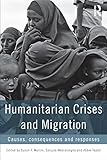Humanitarian crises and migration: causes, consequences and responses / editores: Susan F. Martin, Sanjula Weerasinghe, Abbie Taylor
Martin, Susan F [editor] | Weerasinghe, Sanjula [editor/a] | Taylor, Abbie [editor/a].
Tipo de material: Libro
impreso(a)
Editor: Oxford, England: Routledge, 2014Descripción: xxiii, 375 páginas : ilustraciones ; 24 centímetros.ISBN: 0415857325; 9780415857321.Tema(s): Emigración e inmigración
Libro
impreso(a)
Editor: Oxford, England: Routledge, 2014Descripción: xxiii, 375 páginas : ilustraciones ; 24 centímetros.ISBN: 0415857325; 9780415857321.Tema(s): Emigración e inmigración| Tipo de ítem | Biblioteca actual | Colección | Signatura | Estado | Fecha de vencimiento | Código de barras |
|---|---|---|---|---|---|---|
| Libros |
Biblioteca Campeche
Texto en la configuración de la biblioteca Campeche |
Acervo General | 304.82 H8 | Disponible | ECO040005716 |
Incluye bibliografía e índice: páginas 368-375
Criminal violence, displacement and migration in Mexico and Central America Sebastián Albuja páginas 113-137
List of figures.. List of tables.. Notes on contributors.. Preface and acknowledgements.. Abbreviations.. Part 1.. Introduction and a Theoretical Perspective.. 1 Setting the Scene.. 2 Conceptualizing "Crisis Migration": A Theoretical Perspective.. Part II.. Case Studies of Humanitarian Crises: Movements, Protection Implications and Responses.. 3 Rising Waters, Broken Lives: Experience from Pakistan and Colombia Floods Suggests New Approaches are Needed.. 4 Recurrent Acute Disasters, Crisis Migration: Haiti Has Had It All.. 5 Health Crises and Migration.. 6 Criminal Violence, Displacement, and Migration in Mexico and Central America.. 7 Intractability and Change in Crisis Migration: North Koreans in China and Burmese in Thailand.. 8 Environmental Processes, Political Conflict and Migration: A Somali Case Study.. 9 Environmental Stress, Displacement and the Challenge of Rights Protection.. 10 Enhancing Adaptation Options and Managing Human Mobility in the Context of Climate Change.. 11 Community Relocations: The Arctic and South Pacific.. 12 Something Old and Something New: Resettlement in the Twenty First Century.. Part III.. At-Risk Populations.. 13 Protecting Non-Citizens in Situations of Conflict, Violence, and Disaster.. 14: 'Trapped' Populations: Controls on Mobility at Times of Crises.. 15 Policy Adrift: The Challenge of Mixed Migration By Sea.. 16 Flight to the Cities: Urban Options and Adaptations.. Part IV.. Governance.. 17 The Global Governance of Crisis Migration.. Index
Whether it is the stranding of tens of thousands of migrant workers at the Libyan-Tunisian border, or the large-scale displacement triggered by floods in Pakistan and Colombia, hardly a week goes by in which humanitarian crises have not precipitated human movement. While some people move internally, others internationally, some temporarily and others permanently, there are also those who become "trapped" in place, unable to move to greater safety. Responses to these "crisis migrations" are varied and inadequate. Only a fraction of "crisis migrants" are protected by existing international, regional or national law. Even where law exists, practice does not necessarily guarantee safety and security for those who are forced to move or remain trapped. Improvements are desperately needed to ensure more consistent and effective responses. This timely book brings together leading experts from multi-disciplinary backgrounds to reflect on diverse humanitarian crises and to shed light on a series of exploratory questions: In what ways do people move in the face of crisis situations? Why do some people move, while others do not? Where do people move? When do people move, and for how long? What are the challenges and opportunities in providing protection to crisis migrants? How might we formulate appropriate responses and sustainable solutions, and upon what factors should these depend? This volume is divided into four parts, with an introductory section outlining the parameters of "crisis migration," conceptualizing the term and evaluating its utility. This section also explores the legal, policy and institutional architecture upon which current responses are based. eng
Part II presents a diverse set of case studies, from the earthquake in Haiti and the widespread violence in Mexico, to the ongoing exodus from Somalia, and environmental degradation in Alaska and the Carteret Islands, among others. Part III focuses on populations that may be at particular risk, including non-citizens, migrants at sea, those displaced to urban areas, and trapped populations. The concluding section maps the global governance of crisis migration and highlights gaps in current provisions for crisis-related movement across multiple levels. This valuable book brings together previously diffuse research and policy issues under the analytical umbrella of "crisis migration." It lays the foundations for assessing and addressing real challenges to the status quo, and will be of interest to scholars, policy makers, and practitioners committed to seeking out improved responses and ensuring the dignity and safety of millions who move in the context of humanitarian crises. eng
